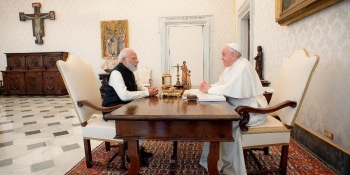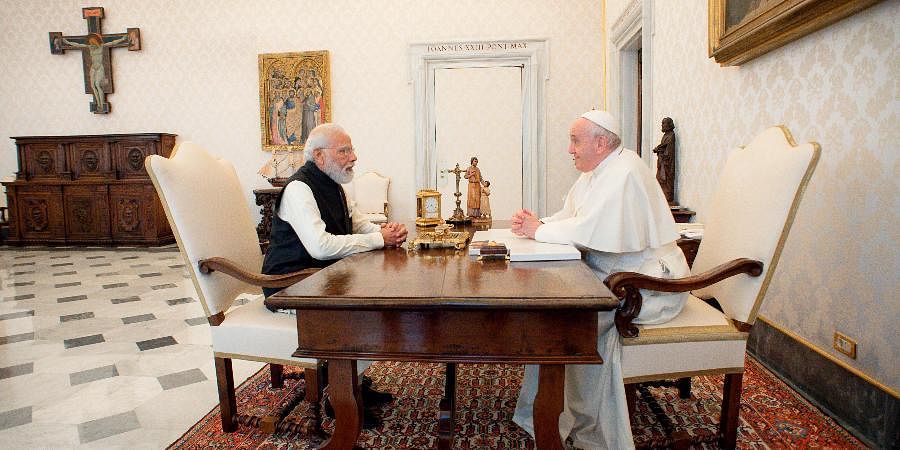
.png) John Dayal
John Dayal

Did Pope Francis raise the issue of persecution of Christians in India and the custodial death of his confrere Stan Swamy with Prime Minister Narendra Modi in the Vatican?
Days after Mr Modi went on to embrace other unwilling heads of government in the climate summit in the United Kingdom city of Glasgow, the question continues to be raised by civil society in India. The Glasgow embraces have in the public mind already replaced those half a dozen photographs of the head of the Catholic Church and the leader of the Indian democratic secular republic smiling, and then embracing each other.
Civil rights activists had helped mobilise public opinion against Islamophobia and Christian persecution, and were active in the defence of Fr Stan during his incarceration in the Bhima Koregaon conspiracy case. They, and a section of the country’s Christian community, remain agitated that perhaps the Church hierarchy has allowed Mr Modi to again escape international censure for the rampant and weaponised Hindutva ravaging the country’s social fabric and community peace.
Unlike Mr Modi’s visit to the United Nations and stopover to meet President Biden and Vice President Kamala Harris, very little official information has been released. The Vatican meeting was without the presence of Indian or international media. In the US, the media was present in force, and the American government released the video recording of Vice-President’s terse reminder on civil liberties and religious freedom in modern democracies.
A report in the Vatican News of 30 October, which covered the meeting, included a backgrounder referred to earlier meetings between Vatican and Indian dignitaries. “Other issues touched on during that meeting were the situation of religious minorities in a country where Christians make up just 2.3% of the population, and the release of Father Stan Swamy, the elderly Jesuit priest and activist for the rights of indigenous peoples, who was imprisoned for nine months on terrorism charges and died in July.”
Columnists, including this one, had to infer from the Pontiff’s gift of a bronze plaque illustrating Isiah 32:15 that unpalatable issues must have been on the table other than the excuse of climate change that brought Modi to Rome, and ensured he was invited to the Vatican. Modi has, to be fair to him, invited Pope Francis to visit India, something he had successfully stalled for seven years despite frequent appeals by the Catholic Bishops Conference of India, and the two Cardinals of the Syro Malabar and Syro Malankara Catholic churches who had met him a few times after he took office.
Social media influencers and civil society activists had nothing but caustic comments and acidic memes that have gone viral in the Indian echo-sphere. Film-maker Anand Patwardhan, one of the leading activists against religious intolerance, asked if the Pope gave an earful to the Indian premier on the custodial death this autumn of octogenarian and ailing Fr Stan Swamy, arrested on fake charges and repeatedly denied bail.
Stan belonged to the Society of Jesus, of which Pope Francis is also a member. The Jesuits had lobbied internationally for the release of Fr Stan. The Jesuit activist working with the indigenous Adivasi people, died of Covid in a Mumbai hospital. His lawyers are in court seeking to clear his name of any criminal stain.
The first of two most viral memes splices an old photograph of Adolf Hitler photo-shopped with Pope Pius XII, with the Modi-Francis visual, while the second shows the Indian premier in the vestments and mitre of a Catholic bishop. No captions were needed. In multi-lingual India, civil society activists wanted them to reach out far and wide.
But even the leadership of denominational and independent churches has been underwhelmed by the result of the visit. The official statements have focused on climate change and recovery from Covid, with no hint of any other issue that may have been discussed.
With over 300 incidents of violence on Christians reported in the first ten months of the year by data keepers of the Evangelical Fellowship of India and Persecution Relief, ordinary Christians and lay leaders feel let down. There are no takers to explanations that the Pope, as head of state of the Holy See, cannot go beyond diplomatically couched language in bilateral talks and no plain-speaking statement can be expected.
For the church in the greater Indian geography, issues of persecution, religious freedom and the rights of the Dalit Christians loom large. No one is spared by the Sangh Parivar and its poisonous tentacles which penetrate metropolises with the same ease that they do spread over smaller towns and villages in North and Central India and states such as Karnataka in the south.
No one is spared. And although an occasional Catholic Bishop or lay leader may say evangelical and Pentecostal churches and independent pastors are inviting trouble with their uninhibited witness to the gospel and church-planting, Catholic clergy, women religious and institutions are not spared.
Nuns were again harassed in Mau district of Uttar Pradesh, which records the highest number of assaults by non-state actors with the complicity of the local police and political leadership. The Nus, who were at a bus-stand to make some enquiries, found themselves surrounded by a Hindutva mob. Young men beat up the driver of the convent vehicle even though he was a Hindu. The Nuns found themselves spending hours in the police station before they were let off.
In nearby Madhya Pradesh, a Catholic school in Satna has been told to put up a statue of Saraswati or face the wrath of the Sangh. This is not an empty threat. A few years ago, a students’ group which had been given space for its activities suddenly showed its political affiliation and challenged the management.
It is another matter of greater concern that the new education policy had hidden in it clauses that may give local non-state actors an entry into school monitoring by way of consultative structures. That there is a larger and well thought out design connecting all these dots are statements by Hindutva religious leaders, political personalities and “bhaktas” calling for the disenfranchisement of Christians [and Muslims], if not expelling them from the country. This is quite in keeping with the foundational teachings of the Sangh, codified in their documents and conveyed discretely to members in their Sunday morning drills and catechisms.
The statements coming out of the RSS headquarters and other groups, even while the Prime Minister was in Rome, show little evidence of a toning down of the anti-Christian rhetoric. The RSS top brass has again argued against conversions and the Christian empowerment and inroads among Adivasis and Dalits.
In states such as Karnataka where the BJP has made major inroads in the last three decades or so has consolidated its position not on the current caste sectors but on a unified Hindu thesis. The survey ordered by a government agency of all churches in the state amidst an outcry of large scale conversions has been momentarily halted after it was challenged in a court of law by civil society.
The Archbishop of Bangalore, Peter Machado, held a press conference to rebuff the government survey of Churches. The Archbishop of Bhopal, Leo Cornelius, wrote to Mr Modi to contain the violence by Sangh activists.
The Catholic community hopes that the visit of Pope Francis to India will materialise soon. The last papal visit was a generation ago, back in 1999. But the moot question is when will it take place and what will be the itinerary? How many places the Pope will be allowed to visit? Will he be able to visit towns such as Ranchi in the middle of the Adivasi belt or Chennai in Tamil Nadu which is a focus of Dalit Christians?
Sangh elements have announced that they would campaign vigorously against the Pope’s visit to India. During the last Papal visit by John Paul II, the Sangh through its Vanvasis wing of the VHP had accused the Pope of encouraging conversions and fomenting dissent and divisions in the country.
Francis, the Pope, the Catholic Bishops Conference of India and diocesan bishops have a great responsibility in strengthening Indian democracy’s main pillars, the freedom of faith, ex